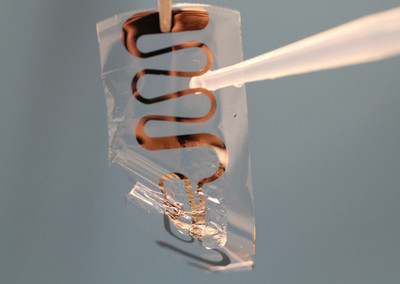Vanishing electronics
Researchers from University of Illinois, Urbana-Champaign, are developing a vast toolbox of materials - from magnesium and silicon to silk and even rice paper - to make biodegradable electronics that can potentially be used in a range of applications.
John Rogers, PhD, University of Illinois, Urbana-Champaign, and his team are developing sensors that can, for example, detect the early onset of swelling and temperature changes in the brain after head injuries and then vanish when they’re no longer needed. Today, devices designed for these purposes are wired - they have to be implanted and later completely removed once they’re no longer needed. Rogers’ sensor could be implanted but work wirelessly and, after use, simply disappear. That eliminates the risk of infection and other complications associated with having to remove devices surgically. Rogers has successfully tested early prototypes of sensors in laboratory animals and envisions that such devices could be used one day in human patients.
His group is also working on biodegradable radiofrequency identification tags, or RFID tags. Currently, RFIDs are produced by the billions and used in everything from jeans for accurately tracking inventory to smart cards, and are injected into pets. They are also found in product packaging that ends up in landfills. Using cellulose, zinc and silicon, Rogers has successfully made dissolvable RFID tags in the lab. The next step would be figuring out how to scale production up and commercialise it.
“We’re quite optimistic,” Rogers said. “We see the way forward and are about halfway there.”

Rogers and Emily Weiss, PhD, Northwester University, are two scientists whose research has been selected at this year’s Kavli lecturers at the 247th National Meeting & Exposition of the American Chemical Society (ACS), the world’s largest scientific society. Rogers will be delivering ‘The Fred Kavli Innovations in Chemistry Lecture’, and Weiss will be delivering the ‘The Kavli Foundation Emerging Leader in Chemistry Lecture’.
Weiss’s lab is focused on getting the most power possible out of mixed and matched nanomaterials that are being developed to maximise renewable energy sources. Scientists can now engineer these materials with unprecedented precision to capture large amounts of energy - for example, from the sun and heat sources. But getting all that energy from these materials and pushing it out into the world to power up homes and gadgets have been major obstacles.
“Electric current originates from the movement of electrons through a material,” Weiss explained.
“But as they move through a material or device, they encounter places where they have to jump from one type of material to another at what’s called an interface. By interfaces, I mean places where portions of the material that are not exactly alike meet up. The problem is when an electron has to cross from one material to another, it loses energy.”
As structures in materials get smaller, the interface problem becomes amplified because nanomaterials have more surface area compared to their volume. So electrons in these advanced devices have to travel across more and more interfaces, and they lose energy as heat every time.
But thanks to the latest advances in analytical instruments and computing power, Weiss’s group is poised to turn this disadvantage into a plus. “Rather than seeing all these interfaces as a negative, now we don’t need to consider it a drawback,” she said. “We can design an interface such that we can get rid of defects and get rid of this slowdown. We can actually use carefully designed interfaces to enhance the properties of your device. That sort of philosophy is starting to take hold.”
Fingertip bandage brings texture to touchscreens
Researchers have developed a haptic device that enables wearers to feel virtual textures and...
Sweat sensor sticker monitors vitamin C in real time
Researchers have developed a battery-free electronic sticker designed to monitor vitamin C levels...
Flexible optical sensor detects pressure and location
Researchers have developed a multi-channel optical sensor that is capable of detecting both the...




